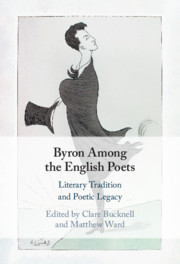Book contents
- Byron Among the English Poets
- Byron Among the English Poets
- Copyright page
- Dedication
- Contents
- Contributors
- Acknowledgements
- Abbreviations
- Introduction
- Part I Inheritances
- Chapter 1 Byron and Shakespeare
- Chapter 2 Not for Envy: Paradise Lost and the Inward Turn in Byron’s Cain
- Chapter 3 Byron and Rochester
- Chapter 4 Byron’s ‘Popifying’: Twice-Told Tales
- Chapter 5 ‘Liquid Lines’: Byron Among the Amatory Poets
- Chapter 6 Byron and Satire post-1760
- Chapter 7 Byron’s English Verse Inheritance
- Part II Contemporaries
- Part III Afterlives
- Index
Chapter 5 - ‘Liquid Lines’: Byron Among the Amatory Poets
from Part I - Inheritances
Published online by Cambridge University Press: 22 July 2021
- Byron Among the English Poets
- Byron Among the English Poets
- Copyright page
- Dedication
- Contents
- Contributors
- Acknowledgements
- Abbreviations
- Introduction
- Part I Inheritances
- Chapter 1 Byron and Shakespeare
- Chapter 2 Not for Envy: Paradise Lost and the Inward Turn in Byron’s Cain
- Chapter 3 Byron and Rochester
- Chapter 4 Byron’s ‘Popifying’: Twice-Told Tales
- Chapter 5 ‘Liquid Lines’: Byron Among the Amatory Poets
- Chapter 6 Byron and Satire post-1760
- Chapter 7 Byron’s English Verse Inheritance
- Part II Contemporaries
- Part III Afterlives
- Index
Summary
An 1809 pen and ink caricature sketch by Scrope Berdmore Davies depicts ‘Ld B. as an Amatory Writer’. It is one of a group of four head-and-shoulders sketches, in profile, that includes their mutual Cambridge friends John Cam Hobhouse and Charles Skinner Matthews, depicted as ‘Two Authors of the Satirical Miscellany’, and a fourth figure, ‘The Satirist’ – possibly Davies himself, but more likely Hewson Clarke, a Cambridge enemy who had criticized Byron’s first published volume Hours of Idleness (1807) in The Satirist.2 But the ‘Satirist’ could also be Byron, for the poetic identity of ‘satirist’ had replaced that of ‘amatory writer’ with the publication of English Bards and Scotch Reviewers in March 1809. Coinciding with Byron’s first trip to Greece, which took place after the publication of English Bards, Davies made the sketch on the back of a letter he sent to Byron in June 1809, when Byron and Hobhouse were in Falmouth, waiting to sail for the Eastern Mediterranean. In its counterpointing of Byron as an amatory poet against the satirist, Davies’ sketch commemorates Byron’s turn from the amatory to the ‘Satirist’ style.
- Type
- Chapter
- Information
- Byron Among the English PoetsLiterary Tradition and Poetic Legacy, pp. 84 - 99Publisher: Cambridge University PressPrint publication year: 2021



